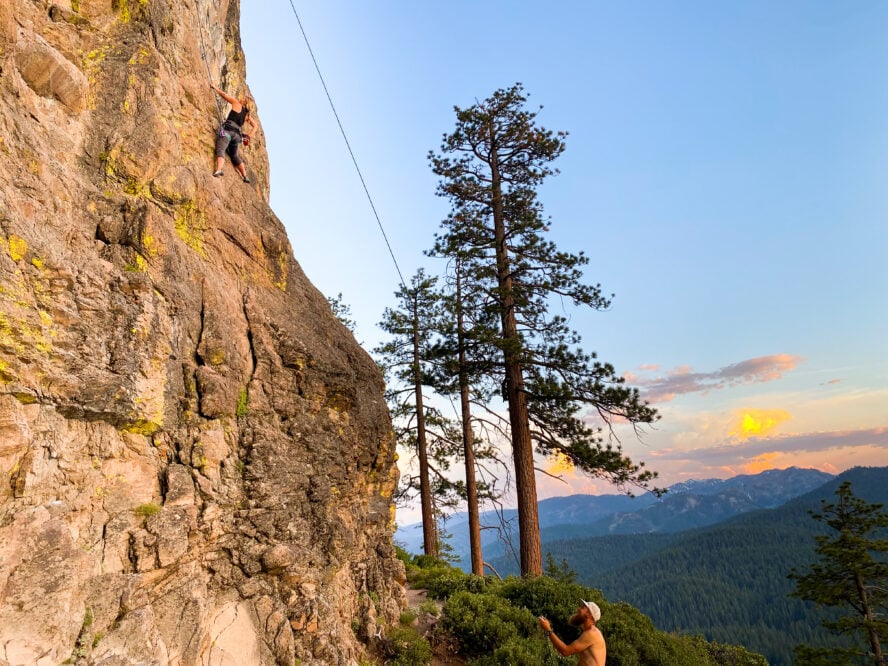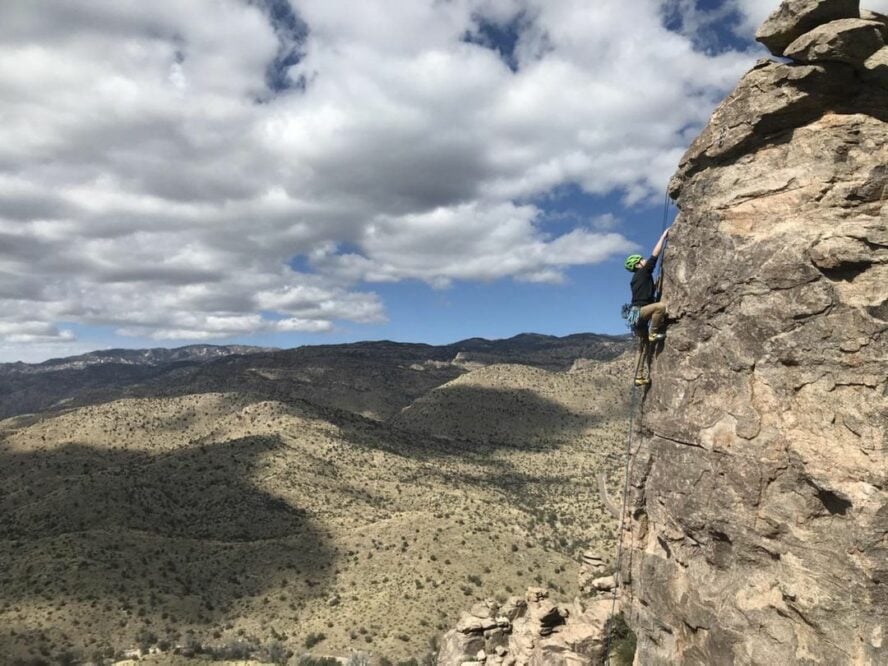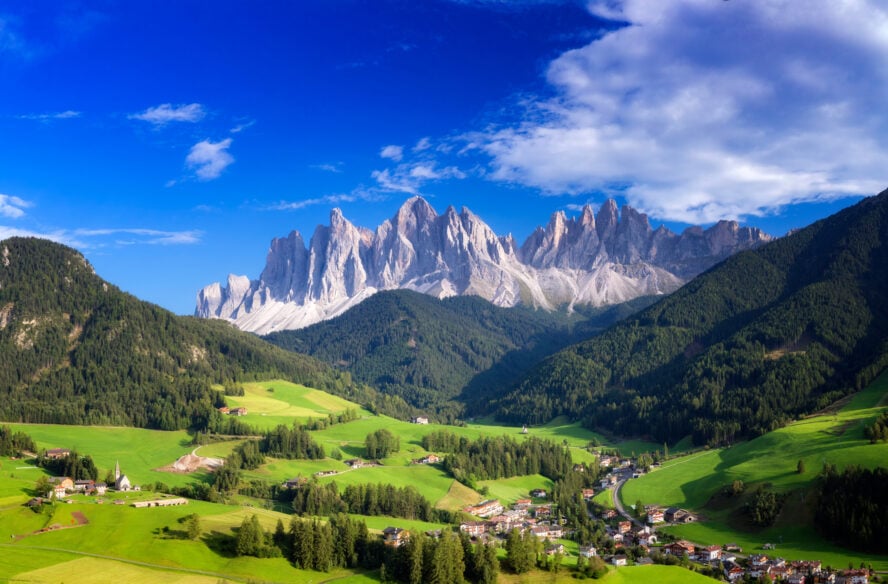I’m driving south on Interstate-15 out of Las Vegas, passing through California’s vast Mojave valleys filled with creosote bushes, yucca trees and a strange alien spacecraft. Oh wait, that’s the Ivanpah Solar Electric Plant. This weird desert, greeting travelers entering the state, perfectly summarizes what California climbing is like. Unlike deep, river-carved gorges found in many of the best climbing areas in the USA, California climbing areas stand out — literally. Many areas are free-standing formations made of granite, rising abruptly out of the landscape that will catch any climber’s eye. Even Yosemite carved by rivers of ice from the last ice age or volcanic flows in Bishop seem to have risen from the earth on their own accord. California climbing consists of areas that are destinations in and of themselves.
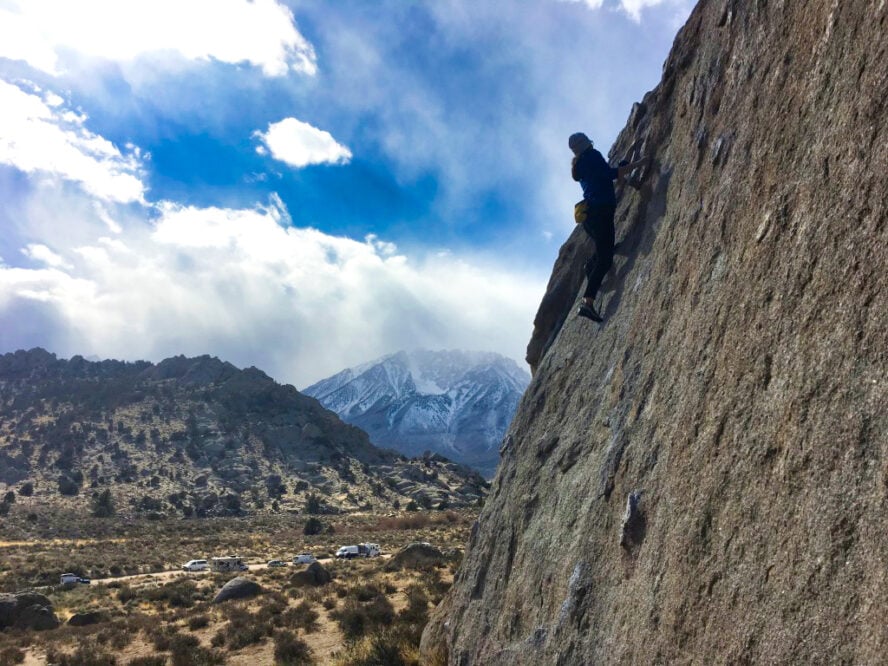
For the climber longing to experience what California has to offer, where should I begin? Granted there are a multitude of destinations for climbers to choose from. Follow me on a journey for the top mountains in California, one of the best places to rock climb in the world.
1. Joshua Tree
Joshua Tree rock climbing appears to take a page from a Dr. Seuss book. Joshua Tree National Park certainly grabs the attention of any onlooker, especially when I gaze upon the strange granite formations sitting among the ghostly looking Joshua trees. For me, Joshua Tree represents a true climber’s retreat and holds a special place in my heart. Campgrounds offer sites a literal stone’s throw from some of the best climbing in the park. You’ll also find many styles of climbing (despite what rumors would have you think) and ample opportunities for desert shenanigans such as cave exploration along the best Joshua Tree hikes.

Joshua Tree redefined how people think about rock climbing in California
Joshua Tree National Park sits on the ancestral lands of the Cahuilla, Serrano, Mojave and Chemehuevi nations. This area also has a storied history among climbers. Beginning with early ascents in the 1950s by the Rock Climbing Section of the Sierra Club with climbers such as a young Royal Robbins, the then National Monument was seen as a mere practice area for better climbing in Tahquitz or Yosemite. Climbers from the late ‘60s through the ‘80s would come to define the style of Joshua Tree rock climbing. You can still climb many of these early classics such as Overhang Bypass, Buissonier, Toe Jam, Double Cross, and The Flake.
Is Joshua Tree sandbagged?
Yes, grades on routes like these may seem strangely hard to the Joshua Tree newcomer. Well, perhaps these climbing routes speak to the easy-to-moderate grades in a time before 5.10. Venture beyond 5.10, though not always, and one may begin to find a groove. Modern routes such as Damper (10a) will feel spot on for many. The bolting may excite others. Installed post-1990, Sexy Grandma (5.9) and Heart of Darkness (5.11) were put up as modern grades took hold. You can certainly find sandbags in these grades, so read those comment sections carefully!
Anyone planning a climbing trip to California should not hesitate to pick up a guidebook such as Joshua Tree Rock Climbs by Robert Miramontes. Is there sport climbing in Joshua Tree, you might ask? You’re in luck. Long hidden from the public eye, the new guidebook, Joshua Tree Sport Climbs and Top Rope Sites by Todd Gordon has been released.

When to go rock climbing in Southern California’s Joshua Tree
Prime climb temperatures are in the spring from late-February to late-April. Given the relatively small size of its formations, you can seek sun, shade, wind or calm generally by walking around the formations base. I also recommend you plan accordingly for the Mojave weather. At the time of this article, entrance fees sit at $30 and are good for seven days. Keep your receipt. An annual pass for climbing in Joshua Tree is $55, but I advise you spring for the $80 Interagency Pass that is good for entrance to nearly all public lands with a fee.
Where to stay and eat when climbing in Joshua Tree
If you plan to camp in Joshua Tree, it’s important to acquaint yourself with the National Park website. Be aware of fees, regulations and limiting your impact. The quintessential climber’s campground is Hidden Valley, which is first-come, first-served and is currently $15 per night. A strict limit of two cars is enforced. This campground is a climber’s campground precisely because it is amongst some of the most concentrated climbing of all grades in the park. For a more guaranteed spot, you can reserve sites at Jumbo Rocks and Indian Cove. All are fairly close to a lot of climbing but generally require a short drive.
Most sites are situated right at the base of the most popular climbs. You don’t really have to drive anywhere when staying at this site. You should arrive early because these sites fill fast. And don’t miss the Climber’s Coffee event each Saturday organized by the NPS Climbing Rangers. Looking for a guide service? There is no shortage of great guides to go out with for a day of rock climbing in Joshua Tree!
Smaller grain size and overall concentration of formations in the Lost Horse Valley, where most of the history of J Tree climbing lies, make this area the most popular and attainable for those new to the area.
By Cody Bradford — AMGA-certified Rock Guide and 57hours contributor
Joshua Tree - Good to Know
Trad, limited sport (mostly “bolt protected”)
Fall, spring
Hidden Valley which is first-come, first-served and is currently $15 per night.
Climber’s Coffee event each Saturday organized by the NPS Climbing Rangers
2. The Needles
I have only climbed on the Tübatulabal ancestral lands within the Needles area once. Yet, I find myself referencing the climbing here all of the time. While it may seem obvious to many climbers visiting this area, the Needles harbor one of the best kept secrets for climbing in California.
Of course, many climbers have heard of the Needles. Given this fact, it’s impressive how quiet this area can be for climbing. Perhaps it’s the demanding nature with its delicate edges and challenging-to-protect cracks. Or maybe it’s the notable lack of current information on this area. The only current guidebooks are The Needles Climbing: A Complete Guide by Kristian Solem. Other guidebooks are out of print. Also, prepare to disconnect: no cell phone reception in the Needles area.

Imaginary Voyage is a comfortable 5.9 for newcomers to the grade
With some of the best climbing in the Sierra Nevada, The Needles command an intimidating presence in the skyline, sitting atop a ridge overlooking the Kern River and Sequoia National Forest. Composed of eight or so formations, The Needles are golden granite spires lightly coated in stripes of green and yellow lichen. Offering a great array of climbing, much of it requires comfort on your feet. Smearing on immaculate granite will be of great use here. Be prepared to climb 5.9 and up. The Imaginary Voyage route is a good introduction to this grade, especially for climbers not wanting to step on the gas immediately. This route also offers a well-protected outing at a modest grade for the Needles with convenient belays almost anywhere you want them.
For technical granite climbing, a good warm-up route could be Igor Unchained, a sustained endeavor. The approach from the main camping area is around three miles. Many climbers stash gear in order to only approach and descend with gear once. There are plenty of hiding spots!
Camping in The Needles
Camping is first come, first served around the Needles Spring area. Sites are a bit before the end of the approach road and a high clearance vehicle is highly encouraged. You’ll also find paid camping ($26-$193 at the time of this writing) at Quaking Aspen Campground, complete with pit toilets, water and established campsites. Quaking Aspen is also located next to the Ponderosa Lodge where you can find hot, cooked meals and other supplies such as water.
Many climbers have heard of the Needles, but it’s still impressive how quiet this area can be for climbing. Perhaps it is the demanding nature of the climbing, with its delicate edges and challenging-to-protect cracks.
The Needles - Good to Know
Granite
Year-round
Intermediate to advanced
The Needles Climbing: A Complete Guide by Kristian Solem
Quaking Aspen Campground
Igor Unchained
3. Bishop
Only a few areas in the country amount to routes available in a single area that outnumber the population of the nearby town. Bishop, California climbing, located on the ancestral lands of the Paiute, is a climber’s paradise all year. When temperatures in the valley soar to the triple digits in the summer, you can find me high up in the Pine Creek drainage where development of sport and traditional climbing is skyrocketing. During the shoulder seasons and warmer winter days, I can easily escape to the Owens River Gorge. In the middle of the valley sits an old lava flow. It’s composed of compacted basalt with crisp, clean edges that are flat, otherwise known as incut, with vertical to overhanging walls. Owens River Gorge has some of the top climbing spots in the Sierra Nevadas.

Pine Creek Canyon is granite climbing with excellent sport potential
Pine Creek Canyon has undergone a renaissance in recent years. A lot of new, tough bolted lines have been put up. For most, however, the classics will typically do. The main draw here is the Pratt’s Crack area, but other lesser known areas offer some of the greatest sport climbing potential this side of Kalymnos rock climbing. Any trad climbers visiting will have plenty to do in the Pratt’s area, which is oftentimes as good as the climbing in the Gunks. It’ll keep you busy on a trip to Bishop. This area is best visited in the late spring, summer or early fall as its elevation and the narrow canyon topography make for cool climbing.
Find four distinct climbing climbing area in Owens River Gorge
The Owens River Gorge is your go-to for California climbing and clipping bolts on the east side of the Sierra. Split into four or so distinct sections, the Upper, Central, Lower and Sub-Gorge areas encapsulate the vast majority of climbing here. The climbing can be steep and many beginners will want to migrate to the Central Gorge where more featured and lower angle rock can be found in the Warm-Up and China Walls areas. Though the approach is long, there is a great trail established by climbers, as well as a pit toilet at the base of the trail. The road is difficult to drive with low clearance vehicles, so drive down the road with caution.
For a bit more solitude, the Upper Gorge and All You Can Eat areas can be excellent. You’ll find a short approach. Lately, my favorite area for projecting has been the Faulty Towers area in the Central Gorge. This area offers fun, overhanging routes that are well equipped.

Things to know before climbing in Bishop
If you are planning to head down to the gorge, don’t rely on your Google Maps to get you there. Instead follow the directions in the guidebook, Owens River Gorge Climbs by Marty Lewis. Spring and Fall are prime seasons for the Gorge. Sun and shade can fairly easily be found, however, within the bends of the walls as they follow the path of the meandering river.
Find plenty of free camping options off of Diablo Road on BLM land. No toilets here, so please hold off until you can get to a proper place. Better, paid camping can be found at The Pit campsite with fully serviced vault toilets for $5 a night per site at the time of this writing. If you plan to be around near the first week of November, consider signing up for a Service Sunday during the American Alpine Club’s Craggin Classic, also known as the Bishop Fall Highball Festival.
When temperatures in the valley soar to the triple digits in the summer, you can find me high up in the Pine Creek drainage where development of sport and traditional climbing is skyrocketing.
Bishop - Good to Know
Traditional, trad, sport, bouldering
Intermediate
Service Sunday during the American Alpine Club’s Craggin Classic
Spring, summer, fall
Owens River Gorge Climbs by Marty Lewis
Diablo Road on BLM land or The Pit
4. Mammoth Lakes
During the height of the summer, rock climbing in California may be too hot in any areas further down the valley. Instead, I often find myself heading to the town of Mammoth Lakes, situated on the Paiute ancestral lands. This is ideal high-elevation rock climbing in Northern California. Best known as a ski town, Mammoth is very quiet during the summer. It also features a range of alpine classic and sport climbing.

Crag climbing spots in Mammoth are perfect for shoulder season
If it’s a taste of the alpine you’re looking for, then head to the Crystal Crag, accessed from the Lake Gorge parking area. Offering a slew of climbing in Northern California at 10,000 feet elevation, check out the North Arete at 5.6 or the South Ridge at low fifth class all the way up to tougher sport climbing in the 5.11 range at the Highlands Wall. This piece of stone has a lot to offer. If clipping bolts are more your speed, I prefer the Clark Canyon area for stellar volcanic tuff with pockets galore. Area 13 holds a great deal of the climbing, especially in the moderate grades. A lot can be found at the Stoned Wheat Thin area where some harder climbing can be found as well as the great multi-pitch sport route, Pull My Finger (5.10a). You can even find great ice climbing near Mammoth during the winter in the towns of June Lake and Lee Vining.
Things to know when climbing in Mammoth Lakes
Visiting Mammoth for a rock climbing trip is definitely best done in the height of summer where temperatures elsewhere are soaring. Shoulder season climbing is still ideal in direct sun at most Mammoth area crags. To make the most of your time, consider hiring a guide to show you around the best spots in Mammoth Lakes. If you are looking for camping, free sites are found along Owens River Gorge road. It should again be noted that there are no amenities here and one should seek a proper toilet. Don’t bury your waste here! At $24 per night, Lake Mary and Twin Lakes campgrounds are excellent, paid options for easy camping.
If it is a taste of the alpine you’re looking for, then head to the Crystal Crag, accessed from the Lake Gorge parking area. Offering a slew of climbing in Northern California at 10,000 feet elevation.
Mammoth Lakes - Good to Know
Multi-pitch, crag
Intermediate
Hot springs are in the area
Summer
Mammoth Area Rock Climbs by Marty Lewis
Lake Mary and Twin Lakes campgrounds
5. Yosemite
Yosemite is an iconic climbing and hiking area wherein lies the ancestral lands of the Ahwahnechee or Awahnichi. One only needs to state the grade of a route to denote the impact this National Park has had on climbing. Indeed, the Yosemite Decimal System, or YDS, gives away Yosemite National Park as THE modern rock climbing destination. To be fair, YDS wasn’t originally created in Yosemite, but rather, Tahquitz. With that kind of legacy, it may be a bit intimidating to first arrive in Yosemite and gaze upon the walls that seem to rise towards the sky indefinitely. While El Capitan and Half Dome steal the show, as anyone who’s been hiking in San Diego might tell you, you’ll find much more to this area than these iconic cliffs. Yosemite is easily some of the best climbing in the world.

Is there sport climbing in Yosemite?
While this may ruffle the feathers of many a Yosemite climber, sport climbing is indeed on the rise and for good reason! As the valley grows in popularity, a few sport crags have popped up. Granted, the grades typically reside in the 5.11 range. You can find a day or so of sport climbing in the 5.8-5.10 range at Five and Dime in the Reed’s Pinnacle area, Pat and Jack Pinnacle or Public Sanitation areas. That said, many folks will come here for the traditional climbing. The Valley holds no shortage of classics! Most will find Cookie Cliff and Manure Pile great intro areas despite the crowds being a bit much to handle at times. Areas like the Brail Book and Royal Arches are good locations, though you’ll also want to find these on the weekend. For anyone looking to get on El Cap, I still find that a trip up Zodiac is a fairly quiet affair. It’s also one of the shortest and best protected aid routes on the formation.
Tuolumne is one of the best California climbing routes in summer
Yosemite Valley certainly steals the show, but this national park has much more to offer. Higher in elevation, Yosemite offers some of the best mountains to climb in California. While the valley climbers often visit in the fall or spring, Tuolumne is the main attraction for summer excursions. Tuolumne meadows sits above 8,000 feet in elevation and hosts a massive amount of large, granite domes. For low fifth-class climbing, Tenaya Peak’s Northwest Buttress is a stellar 5.5 along with the rest of the Cathedral Range. Climbing includes Cathedral Peak’s Southeast Buttress (5.7) and Mathis Crest traverse (5.7). These routes can all be linked together in one long day of stellar, moderate alpine rock climbing.
For more challenging terrain, Drug Dome’s OZ (10d) is not to be missed. Murphy Creek is a nice crag where I’ve taken newer folks single-pitch climbing in Tuolumne. It’s an excellent area with a full range of grades. Further out towards Lee Vining and the east side of the Sierra, you can find Tioga Pass and the impressive Mt. Conness, boasting routes from the low fifth class North Ridge to the Harding Face at 5.10c. This mountain is truly remote and demands some fitness if you want to complete in a day.
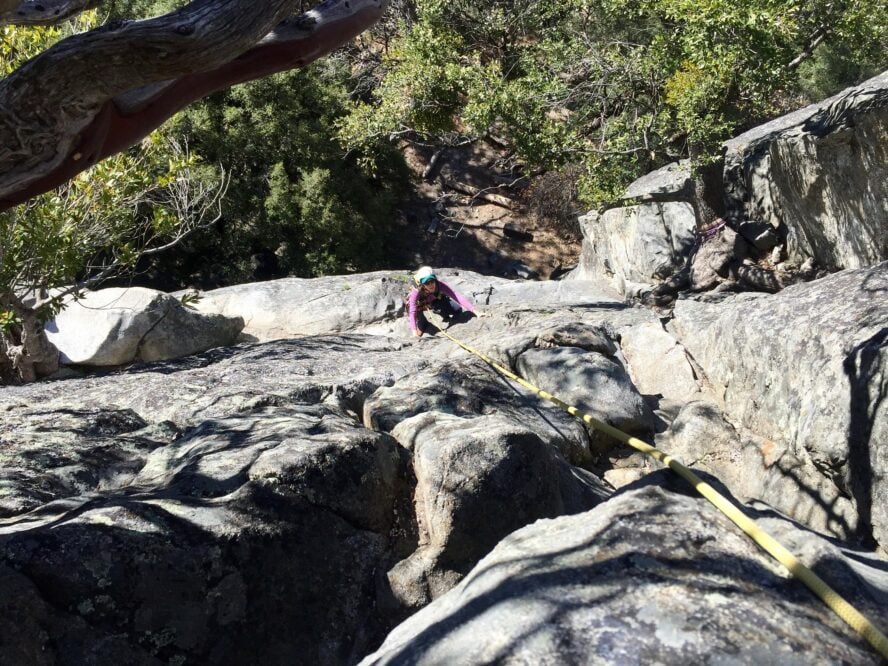
Even though Yosemite is popular, the permit system is low key
Yosemite is no doubt one of the most popular national parks, and not just for climbers. That said, you do not need a permit for climbing any wall in Yosemite with the exception of Half Dome, where you must obtain a wilderness permit. It is not legal to camp at the base of any cliff. You must camp ON the cliff! If you are looking for a Yosemite mountain guide, there are some great ones operating in this area. If you are planning a trip around September, consider being a part of the Yosemite Facelift. Please do your part to care for this incredible resource!
Yosemite offers some of the best mountains to climb in California. While the valley climbers often visit in the fall or spring, Tuolumne is the main attraction for summer excursions.
By Cody Bradford — AMGA-certified Rock Guide and 57hours Ambassador
Yosemite - Good to Know
Classic, sport, crag
All levels
Immerse yourself in Yosemite’s rich history at any of the many museums
Spring, fall
Yosemite Facelift clean up day. Do your part!
Camping on Half Dome
6. Lake Tahoe
Lake Tahoe is a series of granite outcrops encircling a massive lake with some of the best climbing in the Sierras, and big water views to rival the backpacking in Big Sur. Tahoe is also the ancestral lands of the Washoe or Wašišiw. Lover’s Leap, a 250 to 600 foot granite formation, stands out on the horizon near US Highway 50. Named one of the “50 Classic Climbs of North America,” Traveler Buttress is one of the main attractions. Classic guided climbing in Lake Tahoe is available to show you the best sections for your goals in the Sierras. Classic moderates that I can recommend include Bear’s Reach (5.7) and Corrugation Corner (5.7, but I feel it’s more of a 5.8) are ideal for multi-pitch routes. The granite contains not-to-be missed horizontal dikes. The rock also feels like it was built to be climbed. I always enjoy watching this video of Dan Osman speed soloing Bear’s Reach before climbing at Lover’s Leap. It’s a classic Lake Tahoe production.
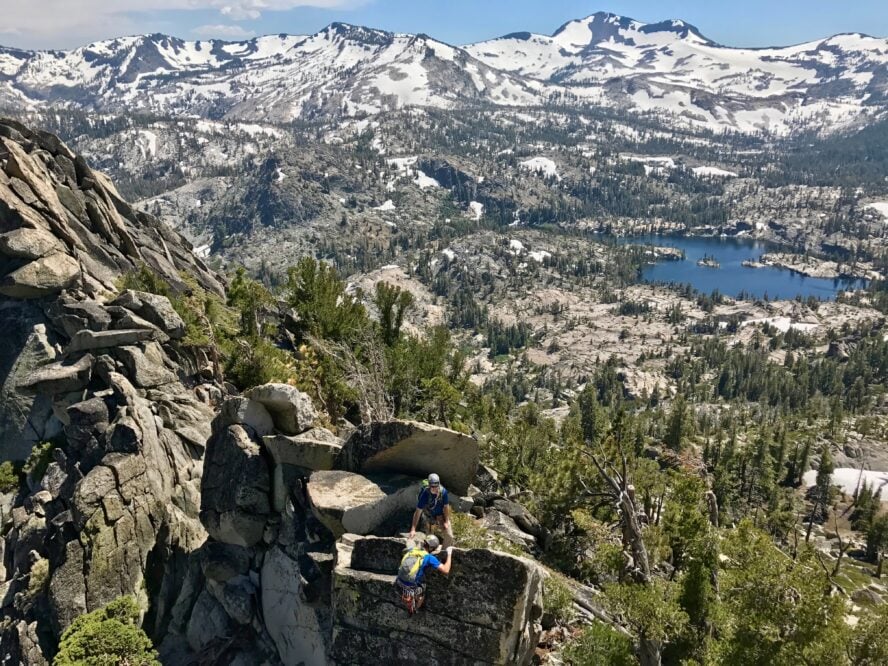
Donner Summit delivers challenging traditional and sport climbing
You will find a hard granite closer to the Tahoe-adjacent town of Truckee, as well as at the Donner Summit. Yes, that Donner. Routes are mixed with single pitch and multi-pitch classic and sport climbing. Anyone looking for bouldering won’t be disappointed. Head to exits 174 and 184 along Interstate-80 to reach the Pacific Crest Trail. The California section of the PCT is the main approach to much of the climbing in the area. The Snowshed Wall and Black Wall are also worth checking out for traditional California rock climbing. Also, prepare for more challenging climbing: most begin at 5.9.
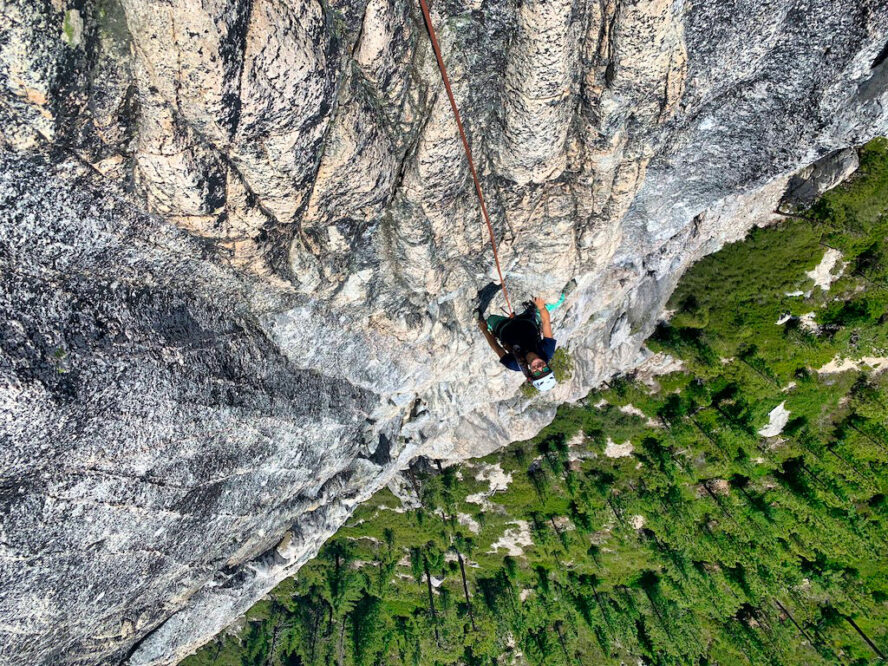
Things to know before climbing near Lake Tahoe
Head to Lake Tahoe for spring to fall climbs. Most of the climbing areas are 5,000 feet, so it’s best left for skiing in the winter. Camping is found nearby on Forest Service Land, but it’s not also clear what is public land or private property. It’s best to know where you’re headed and confirm on a map. I highly recommend the guiding service, Alpenglow Expeditions. They are respectful of the environment here and are part of a strong local community. Plus, all that with local knowledge will help you find the best routes for your goals with more than a few pointers from certified instructors and guides.
The draw for most is the historic Lover’s Leap granite reaching towards the sky near US Hwy 50. Traveler Buttress, another of the 50 Classic Climbs of North America, is a huge draw for climbers to the area.
By Cody Bradford — AMGA-certified Rock Guide and 57hours Ambassador
Lake Tahoe - Good to Know
Multi-pitch, single-pitch, classic, sport
Intermediate to advance
Spend the day at Lake Tahoe
Spring, summer, fall
Rock Climbing Lake Tahoe by Mike Carville
Camping nearby on Forest Service Land



























